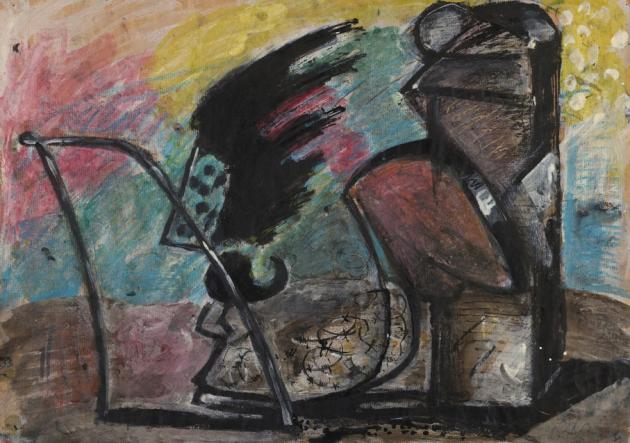The British Museum in London has announced the acquisition of a generous gift of 34 important works on paper by 20th-century German artists to their collection. The works have been donated by Count Christian Duerckheim who holds one of the world’s most comprehensive private collections of contemporary German and English art. Count Duerckheim has presented the Museum with works by Georg Baselitz, Markus Lüpertz, Blinky Palermo, A.R. Penck, Sigmar Polke and Gerhard Richter. Much of the collection was auctioned in May 2011 at Sothebys.
The gift, plus an additional loan of around 60 prints and drawings from the Duerckheim collection, will go on display at the British Museum in February 2014. The gift includes a group of eleven drawings by Baselitz from 1960 to the late 1970s, together with prints from the same period. They cover the principal phases of his career from the Pandemonium drawings of the early 1960s, the development of his ironic ‘Heroes’ in the mid-1960s, the subsequent fracturing of his motifs to the eventual inversion of the motif from the late 1960s. While the seventeen works by Baselitz form half of the gift, there are also an important examples by Richter, including his Pin-up and Installation drawings, the characteristic Ice Age meets cybernetics stick-figures of Penck, as well as sculptural drawings by Lüpertz and Palermo, and a drawing and sketchbook by Polke satirizing the ‘economic miracle’ of post-war reconstruction in West Germany.
In addition, Count Duerkheim has given Erste Konzentration, the enormously significant set of three print portfolios from 1982, comprising some 36 prints by Baselitz, Penck and other German artists associated with the rise of Neo-Expressionism in the early 1980s when their work began to attain widespread international attention. The donation completely transforms the Museum’s holdings of German post-war graphic art. Prior to this the Museum had only one drawing by Baselitz, for example, and no drawings by any of the other artists in the gift, with the exception of Richter. The gift is an important milestone in the Museum’s collection of German graphic art and enables the story of post-war German art to be told.
Count Duerckheim said ‘I am pleased to give this gift to the British Museum so that the important graphic art of 20th century Germany is reflected within its international collection. The exhibition and my collection is a story of change and movement, of life in progress. I have always felt this constant change and have gone with it, very much inspired by the artists I have collected. For me as collector it is a great honour to show my collection and to be a donor to the British Museum’ Neil MacGregor, Director of the British Museum said ‘This is an extraordinarily generous gift to the collection, transforming our modern German holdings and ensuring that the Museum can now trace the history of drawings and printmaking in Germany from the time of Dürer to the present day.
I am hugely grateful to Count Duerckheim for his generosity and for lending us further works from his unparalleled collection to display to the Museum’s wide public’. Count Christian Duerckheim formed his collection of contemporary German art largely from the mid-1970s to the early 1980s. After he first came across the work of Baselitz in the early 1970s, he decided to form a collection that would represent, through key works, the dramatic history of his own times. Count Duerckheim was born in Saxony, near Baselitz’s birthplace, and has always shared a strong bond with the artist which led to him forming one of the most significant collections of his early works in private hands.
The Duerckheim gift will go on display in the exhibition ‘Germany divided: Baselitz and his generation. From the Duerckheim collection’ at the British Museum from 6 February 2014.
Image: Markus Lüpertz MONUMENT – dithyrambic’), 1976. Gouache, ink and oil pastel on brown packing paper. Presented to the British Museum by Count Christian Duerckheim. © Markus Lüpertz/DACS 2013.

